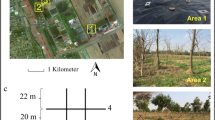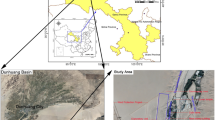Abstract
The moisture content of the municipal solid waste (MSW) is a physical characteristic that plays a fundamental role in the stability and settlement of landfills. However, this physical index is difficult to monitor within the mass of landfilled MSW because it undergoes great variation due, mainly, to the heterogeneity and biodegradation of the waste. Brazilian MSW generally has a large amount of organic matter, that when biodegraded, generates a considerable volume of gases and fluids, aggravated by climatic conditions, such as high rainfall and temperatures. Hence, the importance of obtaining and evaluating the distribution of moisture content in the MSW mass over time. Currently, the electrical resistivity properties have been presented as an interesting approach to obtain the moisture content in landfills indirectly. This study aimed to apply geoelectrical methods as a tool to obtain and evaluate the moisture content distribution in an experimental cell of a sanitary landfill using Archie’s law, which correlates the volumetric moisture content and electrical resistivity. Moisture content values were obtained in laboratory tests with MSW samples collected in two vertical holes and electrical resistivity measurements by means of vertical electrical sounding. The moisture content and the resistivity values of the samples were used to calculate the parameters a and m of Archie’s law. This allowed to convert the resistivity tomography to moisture content tomography. The good correlation achieved between the moisture content calculated by Archie’s law and that obtained from samples indicates that the use of electrical resistivity methods is useful to assess and monitor quantitatively the moisture content in landfills using Archie’s law.











Similar content being viewed by others
References
ABNT. (2004). NBR 10.004: Solid waste—Classification. Rio de Janeiro: Brazilian Association of Technical Standards (ABNT).
Aranda, N., Prado, R. L., Elis, V. R., Miguel, M. G., Gandolfo, O. C., & Conicelli, B. (2019). Evaluating elastic wave velocities in Brazilian municipal solid waste. Environmental Earth Sciences, 78(15), 475. https://doi.org/10.1007/s12665-019-8490-y
Archie, G. (1942). The electrical resistivity log as an aid in determining some reservoir characteristics, Transactions of the AIME, 146, 54–67.
Benatti, J., Paixão Filho, J., Leme, M., & Miguel, M. (2013). Construction of a large-scale experimental cell to obtain hydro-geomechanical parameters of MSW of the city of Campinas, Brazil. In Fourteenth International Waste Management and Landfill Symposium, Margherita di Pula. Proceedings. Sardinia.
Carpenter, P., Calkin, S., & Kaufmann, R. (1991). Assessing a fractured landfill cover using electrical resistivity and seismic refraction techniques. Geophysics, 56.
Dahlin, T., & Zhou, B. (2004). A numerical comparison of 2D resistivity imaging with 10 electrode arrays. Geophysical prospecting, 52(5), 379–398.
Dixon, N., Russell, D., & Jones, V. (2005). Engineering properties of municipal solid waste. Geotextiles and Geomembranes, 23, 205–233.
Dumont, G., Pilawski, T., Dzaomuho-Lenieregue, P., Hiligsmann, S., Delvigne, F., Thonart, P., & Hermans, T. (2016). Gravimetric water distribution assessment from geoelectrical methods (ERT and EMI) in municipal solid waste landfill. Waste management, 55, 129–140.
Feng, S., Bai, Z., Cao, B., Lu, S., & Ai, S. (2017). The use of electrical resistivity tomography and borehole to characterize leachate distribution in Laogang landfill. China. Environmental Science and Pollution Research, 24(25), 20811–20817.
Genelle, F., Sirieix, C., Naudet, V., Riss, J., Naessens, F., Renie, S., & Dabas, M. (2011). Geophysical methods applied to characterize landfill covers with geocomposite. Dallas, USA. https://doi.org/10.1061/41165
Grellier, S. (2005). Suivi hydrologique des centres de stockage de d´echetechetbior. Paris: Ph.D. Thesis Universit´e Pierre et Marie Curie.
Grellier, S., Reddy, K., Gangathulasi, J., Adib, R., & Peters, C. (2007). Correlation between electrical resistivity and moisture content of municipal solid waste in bioreactor landfill. Geoenvironmental Engineering, pp. 1–14.
Grellier, S., Reddy, K., Gangathulasi, J., Adib, R., & Peters, C. (2006b). Electrical resistivity tomography imaging of leachate recirculation in orchard hills landfill. Proceedings of the SWANA Conference, Charlotte, (pp. 1–7).
Grellier, S., Robain, H., Bellier, G., & Shiri, N. (2006a). Influence of temperature on the electrical conductivity of leachate from municipal solid waste. Journal of Hazardous Materials, 137, 612–617. https://doi.org/10.1016/j.jhazmat.2006.02.049
Guerin, R., Munoz, M., Aran, C., Laperrelle, C., Hidra, M., Drouart, E., & Grellier, S. (2004). Leachate recirculation: moisture content assessment by means of a geophysical technique. Waste Management, 24, 785–794.
Helene, L. P., Moreira, C. A., & Bovi, R. C. (2020). Identification of leachate infiltration and its flow pathway in landfill by means of electrical resistivity tomography (ERT). Environmental Monitoring and Assessment, 192(4), 1–10. https://doi.org/10.1007/s10661-020-8206-5
Hu, J., Wu, X. W., Ke, H., Xu, X. B., Lan, J. W., & Zhan, L. T. (2019). Application of electrical resistivity tomography to monitor the dewatering of vertical and horizontal wells in municipal solid waste landfills. Engineering geology, 254, 1–12. https://doi.org/10.1016/j.enggeo.2019.03.021
Imhoff, P., Reinhart, D., Englund, M., Guérin, R., Gawande, N., Han, B., & Yazdani, R. (2007). Review of state of the art methods for measuring water in landfills. Waste Management, 27(6), 729–745.
Jianguo, J., Yong, Y., Shihui, Y., Bin, Y., & Chang, Z. (2010). Effects of leachate accumulation on landfill stability in humid regions of China. Waste management, 30(5), 848–855.
Kaza, S., Yao, L., Bhada-Tata, P., & Van Woerden, F. (2018). What a waste 2.0: a global snapshot of solid waste management to 2050. World Bank Publications.
Kearey, P., Brooks, M., & Hill, I. (2013). An introduction to geophysical exploration. John Wiley & Sons.
Loke, M. H. (2000). Electrical imaging surveys for environmental and engineering studies: A practical guide to 2-D and 3-D surveys. Electronic version available from http://www.terraplus.com
Loke, M., & Dahlin, T. (2002). A comparison of the Gauss-Newton and quasi-Newton methods in resistivity imaging inversion. Journal of Applied Geophysics, 49, 149–162.
Manzatto, M. P., & Miguel, M. G. (2019). Lysimeter validation based on physicochemical characterisation of leachate from municipal solid waste in a tropical region. International Journal of Environment and waste management (Print), 23, 433–449.
Matasovic, N., El-Sherbiny, R., & Kavazanjian, J. (2011). In-situ measurments of MSW properties. In Geotechnical Characterization, Field Measurement, and Laboratory Testing of Municipal Solid Waste (pp. 153–194).
Melges Bortolin, J., & Malagutti Filho, W. (2010). Método da eletrorresistividade aplicado no monitoramento temporal da pluma de contaminação em área de disposição de resíduos sólidos urbanos (in portuguese). Engenharia Sanitária e Ambiental, 15(4), 367–374.
Miguel, M., Paixão Filho, J., Benatti, J., Leme, M., Mortatti, B., &, , et al. (2016). Gravimetric composition of municipal solid waste disposed in a large-scale experimental cell in Southeastern Brazil. International Journal of Environment and Waste Management, 17(2), 128–145. https://doi.org/10.1504/IJEWM.2016.076758
Mishra, S., Tiwary, D., Ohri, A., & Agnihotri, A. K. (2019). Impact of municipal solid waste landfill leachate on groundwater quality in Varanasi. India. Groundwater for Sustainable Development, 9, 100230.
Moretto, R. L., Siqueira Neto, A. C., Elis, V. R., & Miguel, M. G. (2017). Detection of leachate pockets in experimental cell of municipal solid waste with aid of geophysics. Sixteenth International Waste Management and Landfill Symposium. Margherita di Pula: Proceedings Sardinia 2017. CISA Publisher.
Moura, H. P., & Malaguetti Filho, W. (2003). Métodos de Eletrorresistividade e de Polarização Induzida Aplicados na Área de Disposição de Resíduos Urbanos: Aterro Controlado de Rio Claro. Geociências, 22(Esp), 129–139.
Orellana, E. (1972). Direct current geoelectric prospecting (in spanish). Madrid: Ed. Paraninfo, Biblioteca Técnica Philips.
Paixao Filho, J. L., & Miguel, M. G. (2017). Long-term characterization of landfill leachate: impacts of the tropical climate on its composition. American Journal of Environmental Sciences, 13, 116–127.
Racine, J. (2006). gnuplot 4.0: a portable interactive plotting utility. Journal of Applied Econometrics, 21(1), 133–141. https://doi.org/10.1002/jae.885
Shevnin, V., & Modin, I. (2003). IPI2win - 1D interpretation of VES profile. Retrieved 2020, from http://geophys.geol.msu.ru/ipi2win.htm
Telford, W., Geldart, L., & Sheriff, R. K. (1990). Applied geophysics. . Cambridge University Press.
Zekkos, D., Kavazanjian Jr., E., Bray, J. D., Matasovic, N., & Riemer, M. F. (2010). Physical characterization of municipal solid waste for geotechnical purposes. Journal of Geotechnical and Geoenvironmental Engineering, 1231–1241.
Acknowledgements
The authors would also like to acknowledge the Municipality of Campinas for extending their support during the experiment and to the Prototyping Laboratory (LABPRO) of the University of Campinas/Unicamp for their support in the laboratory analysis.
Funding
This work was supported by CNPq (National Council of Technological and Scientific Development, processes numbers 161961/2014–2 and 425971/2016–3) and by FAPESP (Foundation for Research Support of the State of São Paulo, processes number 2010/18560–4).
Author information
Authors and Affiliations
Corresponding author
Additional information
Publisher's Note
Springer Nature remains neutral with regard to jurisdictional claims in published maps and institutional affiliations.
Rights and permissions
About this article
Cite this article
Aranda, N., Elis, V.R., Prado, R.L. et al. Electrical resistivity methods to characterize the moisture content in Brazilian sanitary landfill. Environ Monit Assess 193, 277 (2021). https://doi.org/10.1007/s10661-021-09050-w
Received:
Accepted:
Published:
DOI: https://doi.org/10.1007/s10661-021-09050-w




